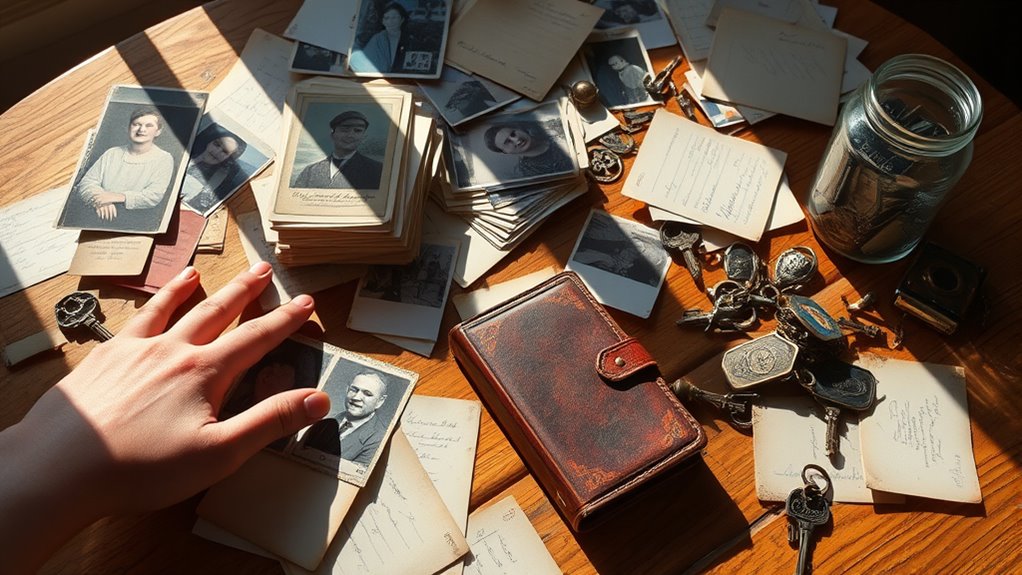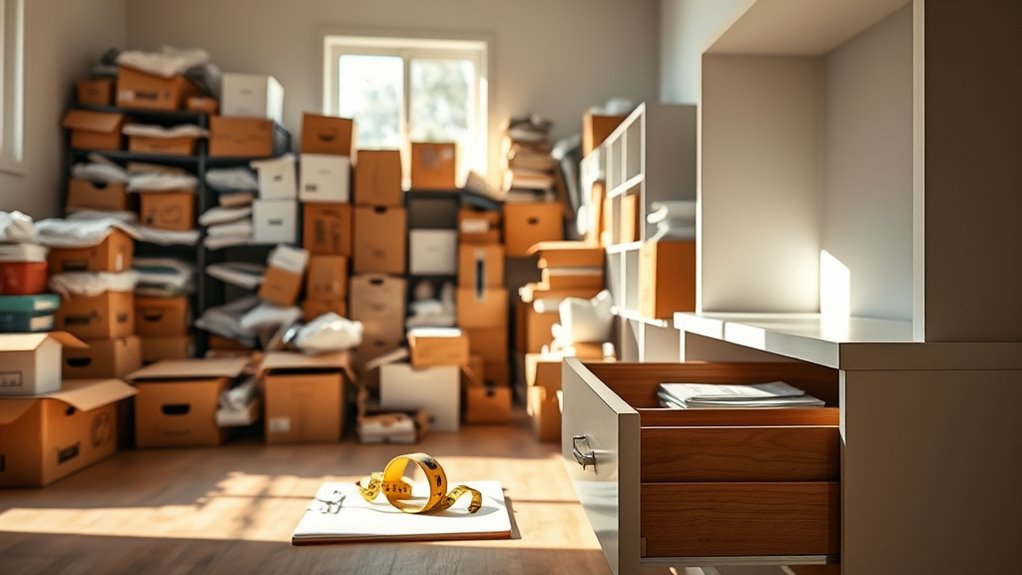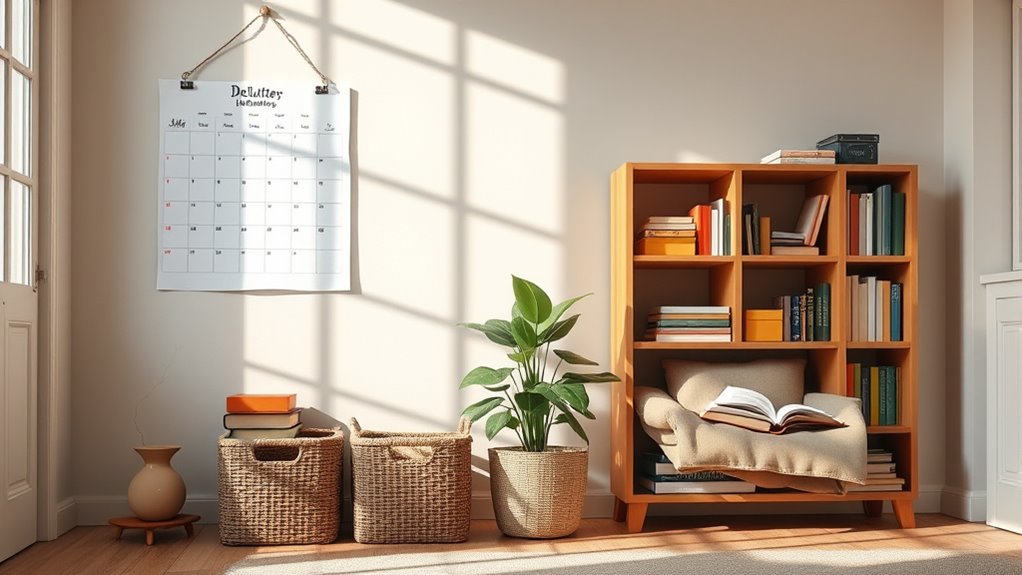If you feel stuck in your decluttering efforts, it's likely because you haven't established a clear strategy. Start by identifying cluttered areas and scheduling specific decluttering times. Don't forget to manage sentimental items—limit what you keep to a memory box and take photos instead. Use efficient organizational techniques, like categorizing items and setting zones for different purposes. Overcoming psychological barriers can help, too. There's more to learn, so let's explore how to fix your approach!
Key Takeaways
- Focus on short, consistent decluttering sessions to avoid overwhelm and decision fatigue.
- Address emotional attachments by creating a memory box and photographing sentimental items.
- Sort items systematically into categories: keep, donate, recycle, and discard for clarity.
- Establish specific organizational zones and implement a "something in, something out" policy to maintain balance.
- Dedicate daily time for tidying and schedule regular check-ins to prevent future clutter buildup.
Establishing a Clear Decluttering Strategy

When you decide to tackle decluttering, creating a clear strategy is essential for success. Start by identifying cluttered areas that need attention, like your closets or kitchen. Schedule specific times for decluttering to maintain consistency, and use short time blocks—15 minutes can work wonders. Developing a routine to prevent clutter from piling up again is vital, as it helps maintain mental clarity in your living spaces, and set achievable goals for each session. As you organize, empty spaces completely, sort items quickly into a trash bag and donation box, and make immediate decisions on what to keep or discard. Regular revisiting of clutter is crucial to ensure your spaces remain organized and peaceful. Clean the spaces before replacing items, and keep donation boxes handy as constant reminders. With a solid plan, you'll find decluttering more manageable and efficient.
Managing Sentimental Clutter Effectively

Decluttering isn't just about clearing physical space; it also involves managing the emotional weight of sentimental items that can clutter your life. You might find it tough to part with items like baby clothes or old photos due to their emotional attachments. Recognizing the emotional roots of attachment is essential for decluttering, as these attachments can complicate the decision to let go. Additionally, understanding how emotional regulation impacts your ability to make these decisions can provide valuable insight into your attachment to these items.
To tackle this, create a designated memory box to store these items, limiting what you keep. Gradual decluttering can ease decision paralysis, allowing you to process emotions like nostalgia without feeling overwhelmed. Consider photographing items to preserve memories without the physical clutter. Regularly review your stored items to ensure they still hold value.
Implementing Efficient Organizational Techniques

Effective organization transforms not only your space but also your mindset. Start by sorting your items into categories: keep, donate, recycle, and discard. This helps streamline your decluttering process. Consider using the "magic basket" technique for daily tidying, collecting items that are out of place. Create specific zones for different purposes, such as storage or relaxation, to enhance overall organization. Implement a "something in, something out" policy to maintain balance in your possessions. Regularly revisit and adjust your categories to ensure ongoing efficiency. For workspaces, arrange items practically, keeping frequently used tools easily accessible. By adopting these techniques, you'll not only declutter but also cultivate a more organized and increased productivity environment. Additionally, remember that regular maintenance of appliances can significantly improve your home's efficiency and organization.
Assessing Storage Needs Before Purchase

Before you invest in storage solutions, it's crucial to assess your current inventory and future needs.
Start by analyzing the types and quantities of items you need to store. Consider potential growth—will your collection increase over time? Pay attention to item characteristics, such as weight and size, and determine if they require special handling.
Evaluate your storage environment: does it need climate control? Assess the available space and ensure it optimizes flow and accessibility. Identify any special storage needs, like security or sanitation. Additionally, be aware that container prices have seen significant increases in recent years, which may affect your budget.
Finally, weigh your options between renting and purchasing. Renting offers flexibility, while buying may be more cost-effective in the long run.
Make informed decisions to meet your storage requirements efficiently.
Overcoming Psychological Barriers to Decluttering

Finding the right storage solutions is just the first step; tackling the psychological barriers that come with decluttering can be a much bigger challenge.
Emotional attachments to items often complicate the process, making it hard to let go of things tied to your identity or memories. You might face decision fatigue, overwhelmed by what to keep or discard. To combat this, consider seeking professional help to navigate your feelings. Additionally, external pressures to declutter can trigger resistance, so approach the process gently. Use supportive communication and respect your autonomy. Recognizing that emotional barriers can hinder progress is essential for moving forward.
Emotional attachments can complicate decluttering, leading to decision fatigue and difficulty in letting go of cherished items.
Breaking tasks into smaller sessions can also help manage procrastination, making decluttering feel more achievable and less daunting. Remember, it's about progress, not perfection.
Creating Long-Term Maintenance Routines

While decluttering can be an ongoing process, establishing long-term maintenance routines ensures your space stays organized and clutter-free.
Start by dedicating 20-30 minutes daily to reset your space—putting items back in their place, laying out clothes, or planning meals. Tidy up each evening to prevent clutter from building up. Daily habits can significantly help in maintaining a tidy environment.
Incorporate weekly tasks like sweeping, mopping, and organizing laundry. Make sure everyone in your household contributes to these routines.
Monthly check-ins help identify areas needing attention, and seasonal decluttering sessions allow you to reassess your organization systems.
Adapting to Changing Organizational Needs

As your life evolves, so do your organizational needs, making it essential to regularly assess and adjust your systems. Start by evaluating what currently works and what doesn't. Identify new priorities based on your changing goals, and implement flexible methods that can adapt as needed. Don't shy away from using technology—tools can streamline your processes and keep you organized more efficiently. Encourage feedback from those around you; it's invaluable for improving your systems. Remember that a mindful approach can enhance your decluttering process and lead to sustainable order in your life.
Frequently Asked Questions
How Do I Stay Motivated During the Decluttering Process?
To stay motivated during the decluttering process, visualize your ideal clutter-free space.
Understand how this change can enhance your life and reduce stress. Set clear, achievable goals for each session, and celebrate your progress with before-and-after photos.
Break tasks into smaller, manageable parts, and don't forget to take breaks.
Enjoy the journey by adding music or inviting a friend to join you.
What Should I Do With Items I'm Unsure About?
When you're unsure about certain items, try the quarantine method: box them up and see if you miss them over time.
Set a deadline for deciding whether to keep or discard them. Consider their sentimental value and practicality—do they bring you joy or serve a purpose? If not, think about donating.
Gradually sort through these items, and remember, it's okay to seek support from friends or join a decluttering group for motivation.
How Can I Involve My Family in Decluttering?
To involve your family in decluttering, start by setting clear goals together.
Assign roles so everyone knows their tasks, making it less overwhelming.
Create a fun atmosphere with music or games, and plan regular sessions to keep momentum going.
Encourage everyone to make decisions about their items and celebrate small victories to boost motivation.
What Are the Best Donation Organizations for Unwanted Items?
When you think of giving, remember the spirit of sharing in "A Christmas Carol."
To donate your unwanted items, consider organizations like The Salvation Army and Goodwill, which accept furniture, clothing, and electronics.
Habitat for Humanity is great for building materials, while Pickup Please supports veterans.
Scheduling pickups is easy—just check their websites or call your local branches.
Your donations can transform lives and strengthen your community!
How Do I Handle Digital Clutter Effectively?
To handle digital clutter effectively, start by assessing your files and apps.
Delete or uninstall anything you don't use regularly. Organize your files with clear, descriptive names and create folders for better navigation.
Schedule regular maintenance sessions to keep things tidy, and limit your downloads to only what you truly need.
Finally, unsubscribe from unnecessary emails to reduce inbox clutter.
These steps can significantly boost your productivity and mental clarity.
Conclusion
In the end, decluttering is like tending a garden; you can't just plant and walk away. You've got to nurture your space, prune away what no longer serves you, and let new systems flourish. With a clear strategy and a mindful approach, you'll transform chaos into calm. Remember, it's not just about getting rid of stuff—it's about making room for what truly matters. So roll up your sleeves and watch your life bloom!









